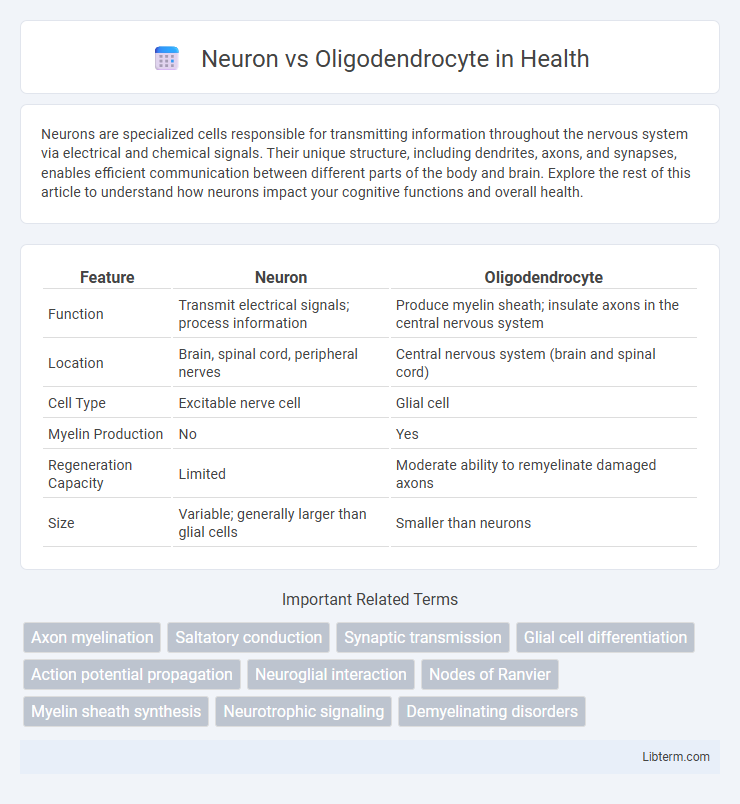Neurons are specialized cells responsible for transmitting information throughout the nervous system via electrical and chemical signals. Their unique structure, including dendrites, axons, and synapses, enables efficient communication between different parts of the body and brain. Explore the rest of this article to understand how neurons impact your cognitive functions and overall health.
Table of Comparison
| Feature | Neuron | Oligodendrocyte |
|---|---|---|
| Function | Transmit electrical signals; process information | Produce myelin sheath; insulate axons in the central nervous system |
| Location | Brain, spinal cord, peripheral nerves | Central nervous system (brain and spinal cord) |
| Cell Type | Excitable nerve cell | Glial cell |
| Myelin Production | No | Yes |
| Regeneration Capacity | Limited | Moderate ability to remyelinate damaged axons |
| Size | Variable; generally larger than glial cells | Smaller than neurons |
Introduction to Neurons and Oligodendrocytes
Neurons are specialized cells responsible for transmitting electrical signals throughout the nervous system, playing a crucial role in sensory input, motor control, and cognitive functions. Oligodendrocytes are glial cells in the central nervous system that produce myelin, a fatty insulating layer that enhances the speed and efficiency of electrical signal propagation along neuron axons. Both cell types are essential for optimal nervous system function, with neurons generating signals and oligodendrocytes facilitating rapid communication by insulating neural pathways.
Cellular Structure: Neuron vs Oligodendrocyte
Neurons possess a complex cellular structure characterized by dendrites, a cell body (soma), and a long axon essential for transmitting electrical signals. Oligodendrocytes exhibit a more compact structure with multiple processes extending to form myelin sheaths around axons in the central nervous system. The primary structural distinction lies in neurons' role in signal conduction versus oligodendrocytes' function in insulating axons to enhance signal speed and efficiency.
Functions of Neurons in the Nervous System
Neurons transmit electrical signals throughout the nervous system, enabling communication between the brain, spinal cord, and peripheral organs. They process sensory input, initiate motor commands, and support cognitive functions such as learning and memory. Unlike oligodendrocytes, which insulate axons by forming the myelin sheath, neurons are the primary cells responsible for signal transmission and information processing.
The Role of Oligodendrocytes in Myelination
Oligodendrocytes play a crucial role in the central nervous system by producing myelin sheaths that insulate neuronal axons, enhancing the speed and efficiency of electrical signal transmission. Each oligodendrocyte can extend its processes to multiple axons, forming segmented myelin layers that reduce ion leakage and facilitate rapid saltatory conduction. This myelination process is essential for maintaining neural circuit integrity and supporting cognitive and motor functions.
Communication Mechanisms: Electrical vs Supportive Signals
Neurons transmit electrical signals through action potentials, enabling rapid communication across neural networks via synapses. Oligodendrocytes provide supportive signals by producing myelin sheaths that insulate axons, enhancing the speed and efficiency of electrical impulse propagation. This complementary relationship between neurons' electrical signaling and oligodendrocytes' myelination is critical for optimal nervous system function.
Key Differences in Development and Origin
Neurons originate from neuroepithelial progenitor cells in the neural tube during embryonic development, whereas oligodendrocytes derive from oligodendrocyte precursor cells (OPCs) that arise later in the ventricular zone. Neuron development involves processes like neurogenesis and differentiation into various types such as sensory or motor neurons, while oligodendrocytes undergo gliogenesis and maturation to form myelin sheaths in the central nervous system. The distinct developmental pathways result in neurons specializing in signal transmission and oligodendrocytes in insulating axons to enhance electrical conductivity.
Interaction Between Neurons and Oligodendrocytes
Neurons rely on oligodendrocytes for efficient signal transmission through the myelination of axons, which enhances electrical conductivity and accelerates nerve impulse propagation. Oligodendrocytes respond to neuronal activity by adjusting myelin sheath thickness and length, optimizing neural circuit function and plasticity. This dynamic interaction supports neural communication, learning processes, and the maintenance of central nervous system integrity.
Importance in Neurological Health and Disease
Neurons are essential for transmitting electrical signals and processing information in the nervous system, while oligodendrocytes provide critical support by forming myelin sheaths that insulate axons and enhance signal conduction. Damage to oligodendrocytes leads to demyelinating diseases such as multiple sclerosis, impairing neural communication and contributing to neurological deficits. Maintaining the health and function of both neurons and oligodendrocytes is vital for preventing neurodegenerative disorders and ensuring effective neural network functionality.
Recent Research and Emerging Insights
Recent research reveals that neurons and oligodendrocytes engage in dynamic bidirectional communication crucial for maintaining neural circuit function and plasticity. Emerging insights highlight oligodendrocytes' role beyond myelination, including metabolic support to neurons and modulation of synaptic activity. Advanced imaging and molecular profiling techniques have uncovered oligodendrocyte precursor cells' potential to influence neuronal regeneration and repair in neurodegenerative diseases.
Conclusion: Neuron and Oligodendrocyte Comparison
Neurons are the primary signaling cells of the nervous system, responsible for transmitting electrical impulses, while oligodendrocytes provide essential support by forming myelin sheaths that insulate neuronal axons to enhance signal conduction. Unlike neurons, oligodendrocytes do not generate electrical signals but play a critical role in maintaining neuronal function and integrity. The functional interplay between neurons and oligodendrocytes is crucial for efficient neural communication and overall nervous system health.
Neuron Infographic

 libterm.com
libterm.com